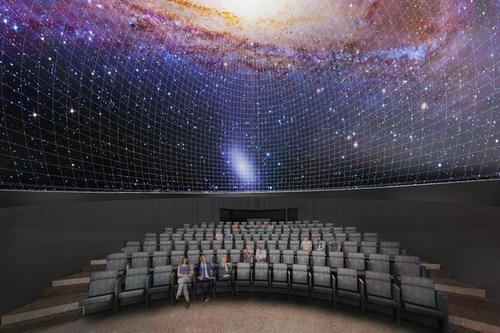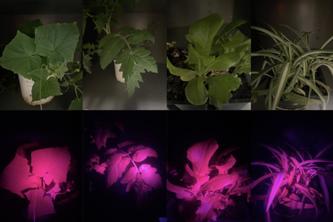
Housed within a concrete cylinder at the heart of the Bell Museum’s new facility on the University of Minnesota’s St. Paul campus sits the Whitney and Elizabeth MacMillan Planetarium. Installation of the dome projection screen begins this week, and will span the next 45 days. This sets the stage for the addition of state-of-the-art audio-visual equipment and theater control system by Sciss, a leading international planetarium developer.
The dome construction involves 44 ribs that tie 226 individual aluminum panels together to form the projection surface. Complete with lighting, audio, and other accessories, the entire structure weighs over 12,000 pounds. Connecting the panels together without any visible seams involves the patented Ulteria seaming process from Astro-Tec, an industry leader in astro science equipment. This cutting edge technology makes the new planetarium the first of its kind in the world.
Capabilities, design, and technology of this space, include:
Astro-Tec Ulteria perforated aluminum projection panels create a virtually seamless dome screen--the first dome of its kind in the world.
The 16-meter dome forms a 360 degree immersive environment.
Sciss Colorspace Display System is powered by an array of high powered computers and two large ultra high-resolution 4K laser phosphor projectors, the latest technology which provides richer color and has light sources that last five years.
Geo-spatial data merges with animations and video to create stunning, true-to-life imagery based on the latest scientific discoveries.
5.1 JBL Digital Sound with Dante and theatrical LED lighting provide the finishing touches.
Sciss confirms that the Bell’s technology places it among the top national planetarium presenters. Sciss also partners with the museum on its portable ExploraDome planetarium, and the Sciss team is excited to be working in Minnesota again. “We look forward to continued partnership with the Bell—they are paving the way to inspire the next generation of astronomers and scientists,” said Mike Dowling, Director of Business Development at Sciss.
“In addition to the planetarium’s world-class technical capabilities, it is also a priority for us to become a leader in providing accessible planetarium shows,” noted Sally Brummel, planetarium program manager. “We will incorporate methods to present live planetarium shows to all communities; sometimes a challenge at other theaters.” The theater is fully wheelchair accessible and the museum will also be piloting audio described shows, “relaxed” presentations, sensory friendly shows and captioning for both live and recorded programs.
When it opens in summer 2018, the new planetarium will have daily programming for the public, as well as a substantial plan to host school field trips and groups that may not otherwise experience the night sky the way that past generations could. “Due to increased light pollution and urbanization, it is estimated that 80% of children won’t ever see the Milky Way Galaxy,” said Bell Museum Executive Director, Denise Young. “Modern planetariums like ours are one way to share this evocative experience with all ages—preschool through college and beyond.”
The Twin Cities metro has been without a public planetarium of this scale for over 15 years, since the Minneapolis Planetarium closed in 2002. The Minnesota Planetarium Society merged with the Bell Museum in 2011, and Parke Kunkle, a longtime member of that group and the Bell Museum advisory board is thrilled to see its return. “Words cannot describe how excited I am—planetaria help us appreciate the importance of physics, chemistry, biology, geology, math AND the arts," said Kunkle.
"An entire generation has missed out on this extremely important resource, but now—through the hard work of many people and supporters—we are bringing one back,” Kunkle continued. Private support from gifts of all sizes has been instrumental in expanding building experiences and programming resources, this includes the ongoing Name a Seat campaign. A donation of $2,500 ensures donor names or personal messages will be permanently engraved on one of the 120 planetarium seats.
Original Planetarium Productions
Written by Minnesota Book Award winner and founder of ScienceDebate, Shawn Otto, the museum’s first original production will be on view with the grand opening. The story explores the formation of the universe from a uniquely Minnesota perspective; investigating the deep geological and cosmic history of the land beneath our feet, as seen through the eyes of a schoolchild on a field trip. The show is being produced in partnership with UK fulldome content producer, NSC Creative.
In addition to the recorded content, every experience will include a live program with audience interaction, led by planetarium educators. Staff will be able to guide visitors through the universe and the Minnesota night sky, and use handheld tablets to respond to questions in real time.
Digital planetariums are also no longer limited to astronomy and space science. The Bell Museum intends to pair its cutting edge technology with the latest data from University of Minnesota researchers to produce data visualizations that span the arts and sciences—taking audiences from the far reaches of the universe to deep inside the human brain. The space will also be available for private rentals and events starting in summer 2018, including weddings under the stars.
Astronomy Education Beyond the Dome
In addition to the planetarium theater, new astronomy and physical science content will be included as part of the museum’s permanent exhibition galleries. Telescopes will be on display in the building for visitors to use. Also, the museum’s rooftop observation deck has built-in mounts for three telescopes for observation events throughout the year.
The Bell Museum will continue in its role as a leading resource for astronomy education in Minnesota, as well. In addition to its network of local and regional planetariums, the Bell will broaden its statewide outreach with the traveling ExploraDome planetarium. Since 2011, the ExploraDome has visited over 450 events for over 80,000 schoolchildren and other learners.
Image downloads
Note: Images available for download below. Limited access to the building at this time.
A set of new renderings and other images (both high resolution and web-ready) are available for download via Google Drive: https://z.umn.edu/bellplanetarium.
About the Bell Museum
The Bell Museum is Minnesota’s state natural history museum, founded in 1872. The museum is part of the University of Minnesota's College of Food, Agricultural and Natural Resource Sciences, and is set to open a new museum and planetarium in 2018. Our mission is to ignite curiosity and wonder, explore our connections to nature and the universe, and create a better future for our evolving world. For details, visit bellmuseum.umn.edu or find @bellmuseum on Twitter, Facebook, and Instagram.
About the College of Food, Agricultural and Natural Resource Sciences
CFANS brings science-driven innovators together to discover hands-on solutions to global challenges. With 10 research and outreach centers across Minnesota, the Minnesota Landscape Arboretum, and the Bell Museum of Natural History, CFANS offers unparalleled experiential learning opportunities for students and the community. CFANS students enter career fields with some of the best job outlooks in the country, including 13 undergraduate majors and over 25 minors from agricultural education and marketing communications to conservation biology and forest and natural resource management, health and nutrition, to the future of food and agriculture management with a focus on business and technology.
- Categories:
- Agriculture and Environment





